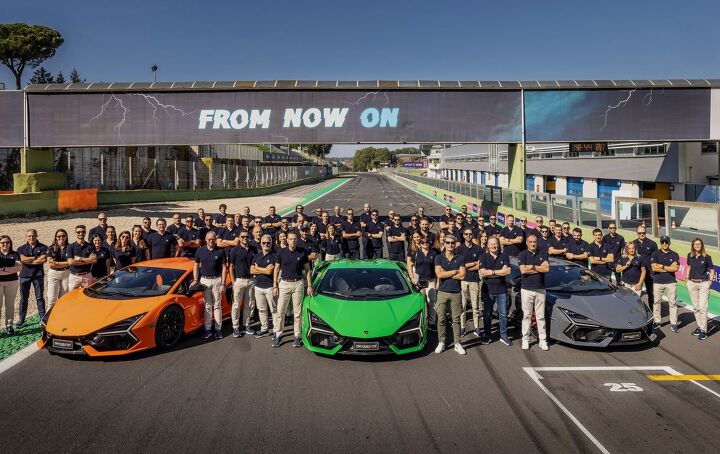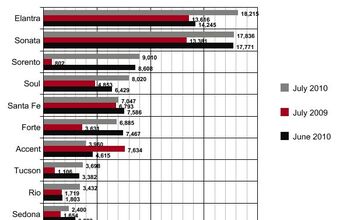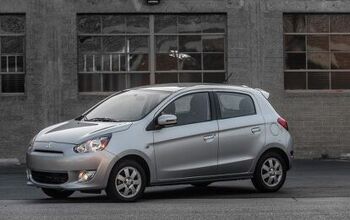Lamborghini Breaks Historic Sales Record

Lamborghini has broken its own sales record by delivering over 10,000 automobiles in 2023. While that’s still less than mainstream manufacturers are pushing out the door in a given week, it represents a major shift in how the brand does business and will likely open it up to additional regulatory scrutiny.
Sales were primarily driven by the Urus, with 6,087 vehicles delivered, and the Huracán, boasting 3,962 units. Analysts have suggested that something like this may not have been possible a decade ago. But with global wealth being transferred upward in recent years, Lamborghini was afforded an opportunity to draw in additional customers with its entry level products. Though, despite these being Lamborghini’s most affordable models, both the Huracán and Urus retail well above $200,000.
From Lamborghini:
The distribution of vehicles delivered was balanced in the three macro-regions, with EMEA showing a 14 [percent] increase over 2022 with a total of 3,987 cars, immediately followed by Americas with a 9 [percent] increase (Total: 3,465) and APAC up 4 [percent] (Total: 2,660). In detail, the United States continued as the top market with 3,000 cars delivered, followed by Germany (961), Chinese Mainland, Hong Kong and Macau (845), the United Kingdom (801), Japan (660), the Middle East (496), South Korea (434), Italy (409), Canada (357), Australia (263), France & Monaco (255), Switzerland (211), Taiwan (131) and India (103).
In terms of model split, the continuing success of the Urus Super SUV was confirmed (6,087 vehicles delivered), followed by another notable record for the Huracán, of which 3,962 cars were delivered. In addition, 63 cars equipped with the iconic V12 were delivered, including the last 12 Aventadors and 51 Few-Offs.
“It’s a true source of pride for the whole company to have surpassed the 10,000-car delivery mark. Playing a role in achieving this milestone for Lamborghini is an honor for me and for all the people who work tirelessly to achieve this goal,” stated Stephan Winkelmann, Chairman and CEO of Automobili Lamborghini. “This is a success made possible by the commitment of everyone, a major accomplishment based on true teamwork. But as always, we’re not stopping at single milestones, and we’re ready to take on more exciting new challenges in 2024.”
While the sales are good news for the brand, breaking the 10,000-unit barrier could come with some complications. The European Union had previously considered allowing specialty, low-volume manufacturers leeway when it comes to adhering to ever-tightening emissions rules. But it has started to move away from the scheme and is still planning to force all manufacturers to stop building everything but all-electric vehicles by 2035. While companies building fewer than 10,000 vehicles annually weren’t subject to the same emissions standards as the big boys, they’re still supposed to prepare for electrification if they want to continue doing business in Europe.
A subset of boutique manufacturers have attempted to convince the EU to rethink the plan by offering exemptions to low-volume brands on the grounds that their products aren’t transportation products but mobile works of rolling art. The premise is that they’re different from mainstream automobiles and should be treated as such.
“We create art pieces that exist for 100 years or more, so they’re not mass-production cars you throw away after 15 years,” Donkervoort Automobielen Managing Director Denis Donkervoort said early in 2023. “We know this because more than 99 [percent] of the cars we’ve ever built are still drivable, and we know this because we still service them.”
Donkervoort and a handful of other low-volume manufacturers are hoping to get around European regulations that would force them to halve CO2 emissions by 2030 and go fully electric by 2035. But they’re targeting an indefinite exemption for automakers building fewer than 1,000 vehicles per year, which wouldn’t pertain to Lamborghini even if it stopped selling the Urus tomorrow.
The theory here could be applied to companies like Lamborghini, however. Boutique brands have alleged that they produce vehicles in such small quantities that the overall carbon footprint is minuscule. Though the kind of people that buy those products are likely to have a much larger impact on the environment than your neighbor who drives an Honda CR-V and won’t need to heat a 10,000 square-foot mansion or fuel the private jet they also don’t own.
Regardless, Lamborghini now sells enough cars to put itself into a different category unless industry regulators are swayed by corporate lobbying efforts. But the Italian brand has fielded several all-electric concepts in recent years and has claimed 2024 will represent its first big push into transitioning its fleet to EVs, now that the time it allotted itself as a “celebration of the internal combustion engine” has concluded.
[Image: Lamborghini]
Become a TTAC insider. Get the latest news, features, TTAC takes, and everything else that gets to the truth about cars first by subscribing to our newsletter.

A staunch consumer advocate tracking industry trends and regulation. Before joining TTAC, Matt spent a decade working for marketing and research firms based in NYC. Clients included several of the world’s largest automakers, global tire brands, and aftermarket part suppliers. Dissatisfied with the corporate world and resentful of having to wear suits everyday, he pivoted to writing about cars. Since then, that man has become an ardent supporter of the right-to-repair movement, been interviewed on the auto industry by national radio broadcasts, driven more rental cars than anyone ever should, participated in amateur rallying events, and received the requisite minimum training as sanctioned by the SCCA. Handy with a wrench, Matt grew up surrounded by Detroit auto workers and managed to get a pizza delivery job before he was legally eligible. He later found himself driving box trucks through Manhattan, guaranteeing future sympathy for actual truckers. He continues to conduct research pertaining to the automotive sector as an independent contractor and has since moved back to his native Michigan, closer to where the cars are born. A contrarian, Matt claims to prefer understeer — stating that front and all-wheel drive vehicles cater best to his driving style.
More by Matt Posky
Latest Car Reviews
Read moreLatest Product Reviews
Read moreRecent Comments
- Bd2 Lexus is just a higher trim package Toyota. ^^
- Tassos ONLY consider CIvics or Corollas, in their segment. NO DAMNED Hyundais, Kias, Nissans or esp Mitsus. Not even a Pretend-BMW Mazda. They may look cute but they SUCK.I always recommend Corollas to friends of mine who are not auto enthusiasts, even tho I never owed one, and owned a Civic Hatch 5 speed 1992 for 25 years. MANY follow my advice and are VERY happy. ALmost all are women.friends who believe they are auto enthusiasts would not listen to me anyway, and would never buy a Toyota. They are damned fools, on both counts.
- Tassos since Oct 2016 I drive a 2007 E320 Bluetec and since April 2017 also a 2008 E320 Bluetec.Now I am in my summer palace deep in the Eurozone until end October and drive the 2008.Changing the considerable oils (10 quarts synthetic) twice cost me 80 and 70 euros. Same changes in the US on the 2007 cost me $219 at the dealers and $120 at Firestone.Changing the air filter cost 30 Euros, with labor, and there are two such filters (engine and cabin), and changing the fuel filter only 50 euros, while in the US they asked for... $400. You can safely bet I declined and told them what to do with their gold-plated filter. And when I changed it in Europe, I looked at the old one and it was clean as a whistle.A set of Continentals tires, installed etc, 300 EurosI can't remember anything else for the 2008. For the 2007, a brand new set of manual rec'd tires at Discount Tire with free rotations for life used up the $500 allowance the dealer gave me when I bought it (tires only had 5000 miles left on them then)So, as you can see, I spent less than even if I owned a Lexus instead, and probably less than all these poor devils here that brag about their alleged low cost Datsun-Mitsus and Hyundai-Kias.And that's THETRUTHABOUTCARS. My Cars,
- NJRide These are the Q1 Luxury division salesAudi 44,226Acura 30,373BMW 84,475Genesis 14,777Mercedes 66,000Lexus 78,471Infiniti 13,904Volvo 30,000*Tesla (maybe not luxury but relevant): 125,000?Lincoln 24,894Cadillac 35,451So Cadillac is now stuck as a second-tier player with names like Volvo. Even German 3rd wheel Audi is outselling them. Where to gain sales?Surprisingly a decline of Tesla could boost Cadillac EVs. Tesla sort of is now in the old Buick-Mercury upper middle of the market. If lets say the market stays the same, but another 15-20% leave Tesla I could see some going for a Caddy EV or hybrid, but is the division ready to meet them?In terms of the mainstream luxury brands, Lexus is probably a better benchmark than BMW. Lexus is basically doing a modern interpretation of what Cadillac/upscale Olds/Buick used to completely dominate. But Lexus' only downfall is the lack of emotion, something Cadillac at least used to be good at. The Escalade still has far more styling and brand ID than most of Lexus. So match Lexus' quality but out-do them on comfort and styling. Yes a lot of Lexus buyers may be Toyota or import loyal but there are a lot who are former GM buyers who would "come home" for a better product.In fact, that by and large is the Big 3's problem. In the 80s and 90s they would try to win back "import intenders" and this at least slowed the market share erosion. I feel like around 2000 they gave this up and resorted to a ton of gimmicks before the bankruptcies. So they have dropped from 66% to 37% of the market in a quarter century. Sure they have scaled down their presence and for the last 14 years preserved profit. But in the largest, most prosperous market in the world they are not leading. I mean who would think the Koreans could take almost 10% of the market? But they did because they built and structured products people wanted. (I also think the excess reliance on overseas assembly by the Big 3 hurts them vs more import brands building in US). But the domestics should really be at 60% of their home market and the fact that they are not speaks volumes. Cadillac should not be losing 2-1 to Lexus and BMW.
- Tassos Not my favorite Eldorados. Too much cowbell (fins), the gauges look poor for such an expensive car, the interior has too many shiny bits but does not scream "flagship luxury", and the white on red leather or whatever is rather loud for this car, while it might work in a Corvette. But do not despair, a couple more years and the exterior designs (at least) will sober up, the cowbells will be more discreet and the long, low and wide 60s designs are not far away. If only the interiors would be fit for the price point, and especially a few acres of real wood that also looked real.


































Comments
Join the conversation
You couldn't GIVE me one of those over-hyped over-priced Lambo-Goonies.
Tesla Model Y first EV to be Europe's No. 1 seller | Automotive News Europe (autonews.com)
Speaking of EPIC sales records by an automaker who was just an upstart joke, barely on the radar screen, 12 years ago.
Oh, and you can bet I am the REAL Tassos, not the coward identity thief punk vegetating around here.